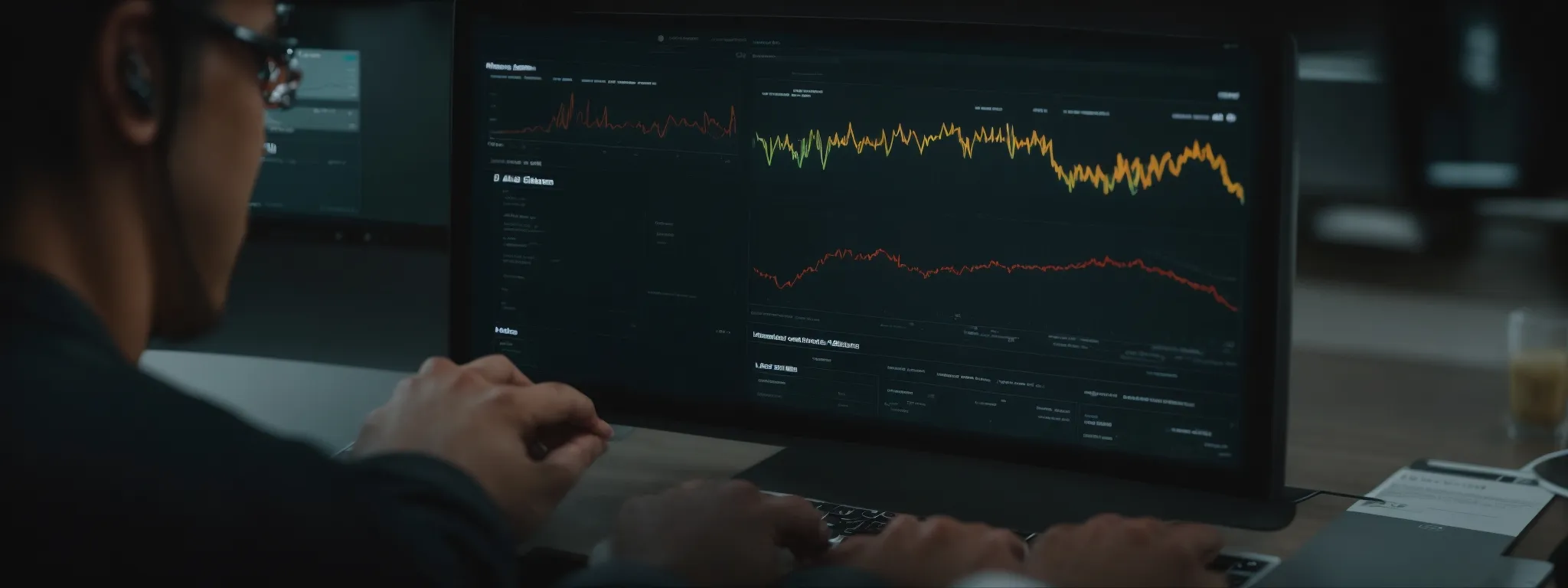SEO Content Audit
Essential Guide to Performing an SEO Content Audit In an ever-evolving digital landscape, the prowess of your content can either catapult you to the summit of search […]
Essential Guide to Performing an SEO Content Audit
In an ever-evolving digital landscape, the prowess of your content can either catapult you to the summit of search engine rank or leave you lost in the abyss of forgotten URLs.
An SEO content audit stands as the beacon that shines light upon the strengths and weaknesses of your website’s content marketing efforts.
It’s an incisive process that dissects your current content inventory to enhance relevance, user experience, and ultimately, search marketing success.
Anchoring your strategy on insights from a well-executed audit aligns closely with your business goals and audience needs.
Keep reading to uncover the systematic approach to bolstering your content’s online visibility and effectiveness.
Key Takeaways
- SEO Content Audits Are Crucial for Aligning Content With Business and SEO Goals to Drive Search Engine Visibility and Success
- Regularly Updating and Refining Website Content Based on Audit Insights Enhances User Experience and Addresses Content Gaps
- Employing the Right Tools, Like SearchAtlas SEO Software, Is Essential for a Thorough Content Audit and Continuous Monitoring of SEO Performance
- Technical SEO Elements, Such as Site Speed and Broken Links, Are Vital for Ensuring a Positive User Experience and Aiding Search Rankings
- Strategic Execution and Monitoring of Changes Post-Audit Are Key to Maintaining and Improving SEO Performance Over Time
Understanding the Basics of SEO Content Audits

An SEO content audit stands as a pivotal process in the operational playbooks of enterprising organizations, who recognize its intrinsic value in shaping content marketing strategy and consolidating search engine presence.
By meticulously evaluating the inventory of web pages and blog content, businesses uncover insights that illuminate content performance, reveal hidden gaps, and harness opportunities for enhancing user experience.
This undertaking meticulously catalogs, analyzes, and appraises every content asset to ensure alignment with business goals, target keywords, and audience expectations.
In addition, the sustained practice of regular content audits delivers a multitude of benefits, not least of which includes the refinement of content marketing efforts and a tangible improvement in search engine rank.
What Is an SEO Content Audit?
An SEO content audit is an analytical review conducted to assess the relevance, effectiveness, and impact of a website’s existing content in relation to SEO performance. Within this audit, a business scrutinizes each individual piece of content, ranging from blog posts and landing pages to video content, to ensure it serves a distinct, valuable purpose in attracting and retaining visitors.
The procedure involves leveraging various content audit tools, like Google Analytics, Screaming Frog, or more specialized offerings from the SearchAtlas SEO software suite by LinkGraph, to extract data on page performance and user engagement. Such an audit not only highlights the strengths of an organization’s content strategy but also pinpoints the critical areas requiring immediate improvement or removal for the betterment of overall SEO services.
Key Benefits of Regular Content Audits
Embarking on regular content audits equips businesses with actionable insights that propel site audits into strategic action items. Content audits pave the way for fine-tuning a website’s content marketing efforts to boost organic traffic, increase click-through rates (CTR), and solidify user engagement:
- Analyzing the existing content library allows an organization to identify and prioritize updates or deletions of underperforming content, thus ensuring a fresher, more relevant content strategy.
- Regular audits facilitate the tracking of SEO performance over time, enabling companies to adjust their strategies in line with evolving search engine algorithms and user behavior patterns.
Additionally, through the discovery of content gaps during an audit, an enterprise gains the foresight to craft compelling content that addresses unmet needs within the target audience, thereby increasing the potential for improved search result standings and audience satisfaction.
Identifying Your Content Audit Objectives

At the onset of a content audit, clarity in defining the objectives forms the cornerstone of a successful evaluation.
This phase demands astute attention to intertwining the strategic business objectives with the granular technicalities of SEO goals.
It’s a concerted effort to chart a course where the assessment of a company’s online content directly contributes to the overarching ambitions of growth and customer reach.
The intention is to not simply inventory content but to shape it into a potent tool that drives search engine visibility and corporate success in unison.
Establish Clear Goals for Your Audit
Embarking on a content audit without clear objectives is akin to navigating without a compass; it is essential to identify what your organization seeks to achieve with the audit.
Set specific, measurable goals that may include increasing organic traffic, enhancing content relevancy for target keywords, or improving visitor engagement and conversion rates:
- Boost organic traffic by identifying and optimizing underperforming pages.
- Enhance relevance by aligning content with target keywords and user intent.
- Improve engagement and conversion by refining content to better meet audience needs.
By solidifying these aims, the audit becomes a focused endeavor, steering efforts towards tangible outcomes that resonate with the company’s SEO content strategy and broader marketing objectives.
How to Align Business Objectives With SEO Goals
Aligning business objectives with SEO goals necessitates a deliberate approach where the pursuit of financial milestones intersects seamlessly with Optimizing Online Visibility. For example, if a company aims to enter new market segments, its SEO services must target content development and keyword strategies that resonate with the search behavior of the intended demographic.
Moreover, the strategic cohesion between company objectives and SEO initiatives becomes evident when SEO metrics like user engagement and conversion rates directly influence the establishment of KPIs for sales growth. Here, LinkGraph’s SEO services guide clients to elevate their search engine positioning while adhering to corporate aspirations.
Preparing for Your SEO Content Audit

Before embarking on an SEO content audit, the selection of appropriate tools and precise assembly of a content inventory are deemed essential.
As organizations gear up for this comprehensive analysis, the weaponry in their arsenal—ranging from sophisticated platforms like SearchAtlas SEO software to free backlink analysis offerings—plays a crucial role in the thorough inspection of content assets.
Coupled with an exhaustive gathering of their website content, companies empower themselves with the resources necessary for executing an effective and revealing audit, setting the stage for optimized content strategy and an improved search engine presence.
Necessary Tools for an Effective Audit
A robust suite of tools is fundamental to navigating the complexities of an SEO content audit. Enlisting the right combination of software, such as the advanced capabilities of SearchAtlas SEO software by LinkGraph, ensures a comprehensive analysis of content assets from a search marketing perspective. These tools serve as the cornerstone for discerning the efficacy of on-page elements, backlink profiles, and user interaction metrics, thereby sculpting the blueprint for strategic optimization.
When preparing for an audit, organizations must consider key functionalities such as backlink analysis and keyword tracking: tools that pierce through data clutters with precision. The judicious use of these instruments, including free backlink analysis and site audit features offered by LinkGraph, provides a granular view of SEO performance, revealing pivotal insights essential for developing a fortified SEO content strategy:
- Analysis of backlink quality and quantity to optimize off-page SEO factors.
- Insightful evaluation of keyword alignment, ensuring content resonates with search queries.
- Assessment of user engagement metrics to refine content for improved visitor retention rates.
Gathering Your Content Inventory
Commencing a content audit incites the task of creating a content inventory—a catalog of all website content elements that an organization intends to examine. This list is pivotal, serving as the roadmap for the entire audit process: it provides a clear perspective on the current state of the company’s content assortment.
| Content Type | Title/Topic | URL | Last Updated | Performance Metrics |
|---|---|---|---|---|
| Blog Post | 5 Tips for On-Page SEO | www.example.com/seo-tips | 2022-08-01 | Page Views, Time on Page |
| Product Page | SEO Audit Software | www.example.com/seo-audit-tool | 2023-01-15 | Conversion Rate, Bounce Rate |
| Landing Page | Explore Our SEO Services | www.example.com/explore-seo-services | 2022-12-20 | CTR, Lead Generation |
The effectiveness of a content inventory is directly related to the granularity and comprehensiveness of data recorded. Decision-makers utilize this detailed record to gauge the resonance of their content with user intent and SEO imperatives, shaping strategies for content rejuvenation or curation accordingly.
Analyzing Your Content’s SEO Performance

As businesses delve into the heart of their SEO content strategy, assessing the SEO performance of their content is non-negotiable.
This rigorous analysis involves evaluating present content against key metrics like keyword effectiveness, searching for strengths and weaknesses in organic search traffic, and meticulously uncovering both gaps and redundancies in content offerings.
Each of these pillars—keywords, traffic, and content relevancy—plays a critical part in building a robust SEO foundation, capable of withstanding the competitive tides of search engine rankings.
Assessing Keyword Effectiveness
The precision with which content taps into the right keywords can make or break its search engine success. In assessing keyword effectiveness, LinkGraph’s SEO services meticulously comb through SEO content, scrutinizing whether the choice of keywords aligns with the intended user query and the content’s core message.
An in-depth evaluation lays bare the impact of target keywords on content’s search engine visibility and user traction. These insights guide strategic refinement, ensuring every content asset not only appeals to its audience but also speaks the language of algorithms:
| Content Asset | Primary Keyword | Search Volume | Current Position | Competitiveness |
|---|---|---|---|---|
| Ultimate Guide to On-Page Optimization | On-Page SEO | 7,600 | 15 | High |
| Local SEO Strategies for Businesses | Local SEO Services | 2,500 | 8 | Medium |
| Maximizing Backlinks Through Effective Outreach | White Label Link Building | 1,200 | 22 | Low |
Evaluating Organic Search Traffic
Evaluating organic search traffic is a critical step in understanding the value and reach of an organization’s content. By analyzing the volume of users visiting the website from search engines, insights into the effectiveness of current SEO practices and content relevance to user search intent can be yielded.
| Content Asset | SEO Traffic (Monthly) | Bounce Rate | Average Session Duration | Pages Per Session |
|---|---|---|---|---|
| In-depth SEO Guide | 3,200 | 70% | 2 min 30 sec | 3.5 |
| Comparative Analysis of SEO Software | 1,500 | 65% | 3 min | 4.2 |
| Case Study: SEO Success Stories | 2,800 | 60% | 5 min | 5.1 |
Furthermore, dissecting the characteristics of traffic, such as bounce rates and session durations, affords a detailed understanding of user engagement. These metrics serve as indicators of the content’s ability to capture and maintain the attention of visitors, reflecting the alignment with user interests and search queries:
Identifying Content Gaps and Overlaps
In the realm of search marketing, the identification of content gaps and overlaps is instrumental in devising a strategic roadmap for SEO success. Content gaps signal missed opportunities in a content library, areas where audience interest or search intent is not adequately met by the existing content offerings.
Conversely, overlaps may indicate redundancies that can dilute a website’s thematic focus and potentially weaken its search engine rank due to cannibalizing its own search results. Identifying these critical elements guides content creators in finetuning their SEO content strategy:
| Content Analysis | Identified Need | Impact on SEO | Planned Action |
|---|---|---|---|
| Content Gap | Advanced SEO Techniques | Untapped Potential Audience | Develop In-depth Educational Content |
| Content Overlap | Basic SEO Tips | Diluted Topic Authority | Merge and Refine Multiple Pieces |
Evaluating Content Quality and Relevance

In the digital age, where content is king, the evaluation of content quality and relevance becomes the linchpin of a successful SEO strategy.
As businesses scrutinize their online footprint, they must pay heed not only to the mechanics of SEO, but also to the substance and value that their content provides to users.
The process of auditing for user engagement and assessing content freshness and accuracy is exacting work that requires a keen eye for detail and a commitment to sustaining the highest standards of digital content.
This segment delves into key methodologies for ensuring that web pages and articles not only rank high on search engine result pages but resonate profoundly with the target audience, serving their informational needs with precision and authority.
Auditing for User Engagement
In assessing user engagement, LinkGraph’s methodical approach factors in an array of analytics that reflect audience interaction with content. Metrics such as dwell time, pages per session, and comments or shares, serve as the barometers for gauging the effectiveness of content in captivating the user’s interest and fostering a participatory community.
| Content Element | Comments | Shares | Time on Page | Pages per Session |
|---|---|---|---|---|
| Comprehensive SEO Tutorials | 45 | 150 | 4 min 20 sec | 2.9 |
| SEO Case Study Reviews | 30 | 75 | 5 min 10 sec | 3.4 |
| Innovative Content Strategy Insights | 25 | 40 | 3 min 45 sec | 2.5 |
With the deployment of advanced tools like SearchAtlas SEO software, the audit becomes a granular investigation into the nuances of visitor behavior. As brands seek to optimize their online presence, insights derived from these engagement metrics equip them to refine their content offerings and foster an environment conducive to Sustained Interaction and Loyalty.
Assessing Content Freshness and Accuracy
The vitality of content within the landscape of search engine optimization necessitates a vigilant assessment of freshness and accuracy. LinkGraph’s SEO services underscore the importance of ensuring that content is not only current with the latest industry standards and practices but also factually precise, fostering trust and credibility among users and search engines alike.
Indeed, staleness and inaccuracies can significantly impede a website’s ability to climb the rankings of search results. Through rigorous scrutiny, businesses benefit from LinkGraph’s meticulous approach to refreshing outdated information and amending any elements of content that could compromise the user’s quest for reliable knowledge and guidance.
Reviewing Your Website’s Technical SEO Factors

When it comes to reinforcing a website’s SEO foundation, attention must also turn to the spectrum of technical factors influencing search engine performance.
The integrity of a site’s architecture is paramount, laying the groundwork for successful indexation and optimal user experiences.
As part of a holistic SEO content audit, the rigorous examination of technical elements such as broken links and site errors, coupled with the analysis of site speed and mobile usability, emerges as critical tasks.
These assessments probe the operational efficiency of a website, ensuring that technical SEO not only complements content efforts but also bolsters visibility and user satisfaction in the digital marketplace.
Checking for Broken Links and Errors
LinkGraph’s SEO services prioritize the detection and resolution of broken links and errors as a fundamental practice in technical SEO audits. Recognizing that such issues can severely disrupt user experience and hinder search engine crawlers, LinkGraph ensures thorough examination and prompt rectification of these critical website elements.
The meticulous process involves examining each web page to identify any link that fails to direct visitors to the intended destination:
| Web Page | URL with Broken Link | Error Type | Action Taken |
|---|---|---|---|
| About Us | www.example.com/about/partners | 404 Not Found | Link Updated |
| Services | www.example.com/services/seo-audit | 500 Internal Server Error | Error Investigated and Resolved |
| Contact | www.example.com/contact/new-office | 302 Found | Redirect Confirmed |
Errors are categorized, and based on their impact, LinkGraph’s team formulates an action plan to enhance the website’s technical integrity, thereby supporting its overall SEO prowess and user accessibility.
Analyzing Site Speed and Mobile Usability
Analyzing site speed and mobile usability is integral to bolstering a website’s user experience and search engine standings. LinkGraph’s SEO services sharpen their focus on these aspects, acknowledging that swift load times and seamless mobile navigation are essential to maintaining visitor engagement and minimizing bounce rates.
Through comprehensive testing procedures, LinkGraph assesses a website’s responsiveness across various devices, ensuring consistent accessibility and an optimized browsing experience. Improved site speed and mobile friendliness are not merely about convenience; they position websites favorably in the eyes of search engines and users alike:
| Web Page | Load Time | Mobile Usability Score | Recommended Improvements |
|---|---|---|---|
| Homepage | 2.3s | 98/100 | Image Compression |
| Blog Index | 3.5s | 95/100 | Eliminate Render-Blocking Resources |
| Contact Page | 1.8s | 99/100 | Minify CSS |
Developing a Content Optimization Strategy

In the landscape of digital marketing, developing a content optimization strategy is crucial to maximize the efficacy of a website’s content and bolster its SEO standing.
The strategy entails a nuanced approach for updating and refining content, ensuring it remains relevant, engaging, and authoritative.
It also requires astute decisions regarding content removal or consolidation, which streamlines the site and eliminates redundancy.
Together, these tactics enhance the comprehensiveness and coherence of the content library, positioning a website to achieve improved search engine visibility and user engagement.
Prioritizing Content Updates and Improvements
In the echelons of modern digital marketing, realizing which content to prioritize for updates and improvements is a discerning step in refining an SEO content strategy. A content’s importance is gauged by its traffic, engagement, and conversion metrics, allowing for a Meticulous Approach to Enhancement.
| Content Priority | Page Title | Assessment Criteria | Strategic Action |
|---|---|---|---|
| High | Advanced SEO Techniques | High Traffic, Low Conversion | Optimize CTA and User Journey |
| Medium | SEO Best Practices | Decreasing Engagement | Update with Trending Topics |
| Low | Historical SEO Data | Outdated Information | Archive or Merge with Recent Data |
LinkGraph guides its clients through optimizing their most critical content first, aligning efforts with measurable goals such as increased organic reach or improved user interaction. The impetus behind this strategy: concentrate resources on areas that promise the greatest return on investment, ensuring each content asset achieves its maximum potential.
Planning for Content Removal or Consolidation
As part of a comprehensive SEO content strategy, LinkGraph’s SEO services emphasize the importance of determining the fate of underperforming or outdated content pieces. The consideration for content removal or consolidation is rigorously based on their analyzed contribution to a website’s SEO performance and alignment with current content trends and audience needs.
When deciding whether to remove or amalgamate content, the critical factors include redundancy, audience engagement levels, and overall relevance to the intended search queries and topics. Organizations must weigh these considerations with precision:
- Assess each content asset for its unique value and potential impact on site authority.
- Determine the potential benefit of merging similar topics to create comprehensive cornerstone content.
- Proceed with content removal when it serves no strategic purpose or risks detracting from the user experience.
Executing the SEO Content Audit Recommendations

Successful completion of an SEO content audit culminates in the strategic execution of findings, an exercise of paramount importance for businesses committed to elevating their digital presence.
Tackling the aftermath of the audit requires a systematic approach—strict scheduling, meticulous implementation of changes, and continual monitoring of SEO performance to gauge the outcomes.
This stage is the transformative journey from data-driven insights to measurable SEO enhancements, solidifying the footing in search rankings and user experience.
Scheduling and Implementing Changes
Upon dissecting the results of an SEO content audit, LinkGraph’s SEO services advise on the vital step of strategically scheduling the execution of recommendations. The essence of success in this endeavor lies in the prudent planning of updates, ensuring that changes are rolled out in a manageable, sequenced manner that aligns with the ongoing marketing calendar and technical capacity of the organization.
Implementation of these audit-driven modifications is a delicate process that demands attention to detail and responsiveness to the evolving digital landscape. LinkGraph’s expert team is adept at promptly executing changes across content assets, ensuring that each adjustment adheres to the established timeline while maximizing the positive impact on search engine optimization performance.
Monitoring SEO Performance Post-Audit
Following the implementation of SEO content audit recommendations, the vigilance of monitoring SEO performance becomes LinkGraph’s subsequent focus. Analysis of incremental changes in organic search rankings, user behavior metrics, and conversion rates sheds light on the efficacy of the implemented strategies, informing any necessary course corrections to maintain upward momentum in SEO results.
LinkGraph’s comprehensive suite of tools, including the Sophisticated SearchAtlas SEO Software, provides ongoing scrutiny of SEO performance post-audit. This essential follow-up ensures that the refined content continues to align with the evolving demands of search engines and the anticipated needs of the audience, solidifying the website’s authority and relevance in the digital landscape.
Maintaining SEO Health With Periodic Content Audits

In the perpetual endeavor to optimize search engine performance, sustaining SEO health through regular content audits is non-negotiable for businesses striving for online visibility.
Vigilance in this realm mandates a systematic approach: setting a routine for future SEO audits ensures the continual alignment of content with both user intent and the latest search engine guidelines.
Similarly, staying current with SEO best practices is essential for maintaining the adaptability required to navigate the dynamic digital landscape effectively.
This guide directs organizations in instituting these practices, affirming their commitment to SEO excellence.
Setting a Routine for Future SEO Audits
Establishing a systematic timetable for subsequent SEO content audits is imperative for businesses intent on preserving the vitality of their digital presence. LinkGraph’s SEO services advocate for routine audits, ideally biannually or annually, to remain abreast of the ever-evolving search engine algorithms and user engagement trends. Proactive scheduling of these audits can preempt SEO issues and keep content strategies agile and responsive to market dynamics.
Adherence to a predefined audit routine facilitates the continuous optimization of an organization’s content, ensuring its alignment with strategic business objectives and SEO benchmarks. Through LinkGraph, companies can Establish Audit Calendars that integrate seamlessly with their broader digital marketing initiatives, fostering sustained growth in organic search visibility and user experience enhancements over time.
Staying Current With SEO Best Practices
Staying current with SEO best practices is imperative for businesses aiming to attain and maintain a competitive edge in the digital marketplace. LinkGraph’s SEO services proffer cutting-edge expertise, ensuring clients’ content marketing strategies adhere to the latest search engine guidelines and user experience design trends.
Engagement with the continuous flow of industry updates, algorithmic changes, and the evolution of SEO tactics is critical for preserving the relevance and efficiency of an SEO content strategy. By drawing on resources such as SearchAtlas SEO software, clients receive precise recommendations tailored to the current state of search engine landscapes:
| SEO Best Practice | Influence on SEO | LinkGraph’s Services |
|---|---|---|
| Mobile-First Optimization | Enhances rankings in mobile search results | Comprehensive mobile usability analysis and recommendations |
| Quality Backlink Acquisition | Boosts domain authority and referral traffic | Strategic white label link building and backlink audits |
| High-Quality Content Creation | Drives user engagement and organic reach | Execution of SEO content strategy with an emphasis on relevance and readability |
Conclusion
An SEO content audit is critical for aligning a business’s online content with its strategic goals and enhancing its search engine ranking.
By undertaking consistent audits, companies can ensure content remains relevant, discover and fill gaps in their content library, and remove or update underperforming articles.
The audit process involves analyzing key metrics such as keyword effectiveness and user engagement, as well as reviewing technical SEO factors like site speed and mobile usability.
Armed with these insights, businesses are better positioned to develop and implement a content optimization strategy that boosts organic traffic, improves user experience, and amplifies overall digital marketing success.
Staying committed to periodic audits and adhering to SEO best practices are essential for maintaining a website’s SEO health and competitive edge in the ever-changing digital landscape.














































































